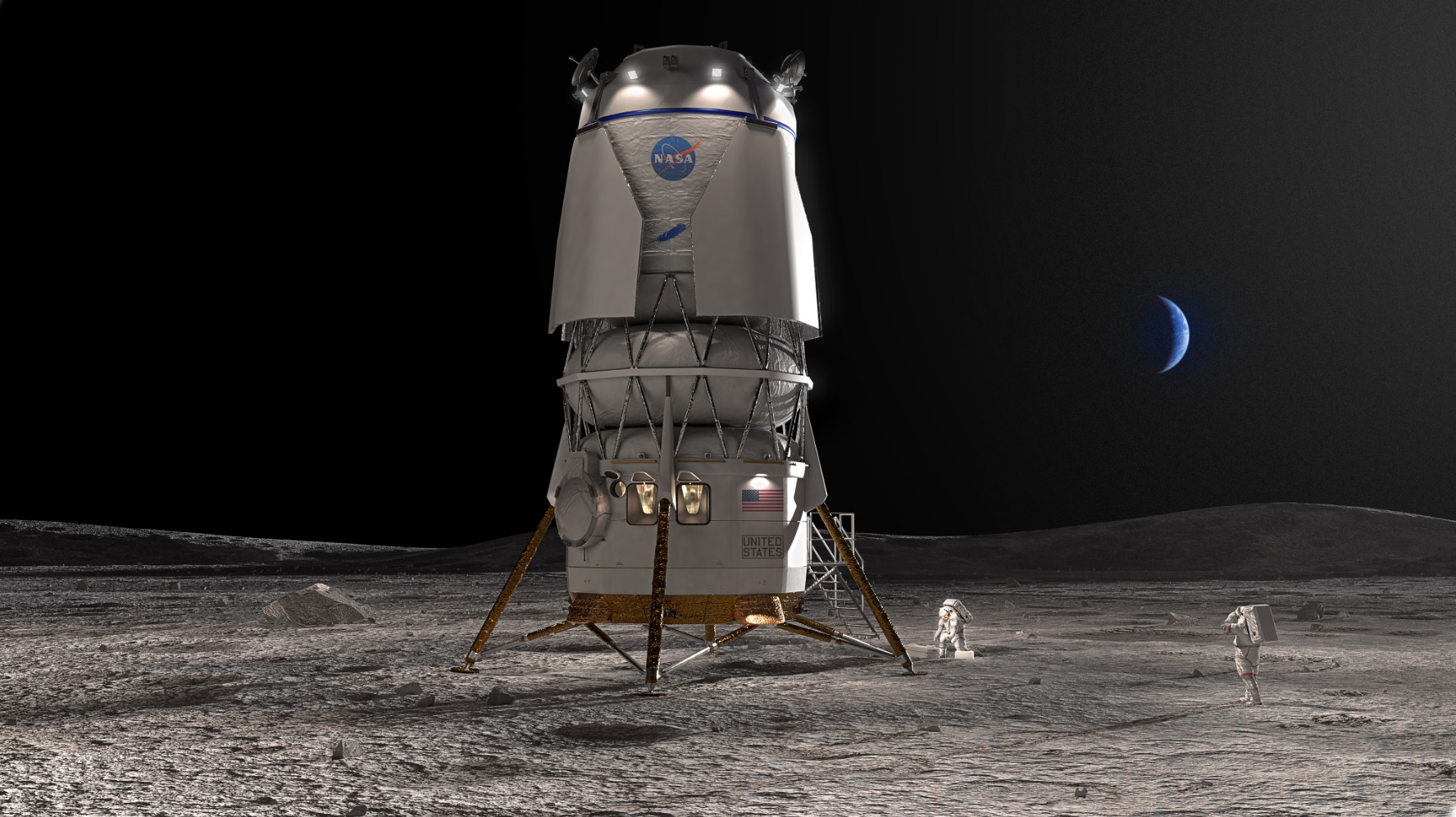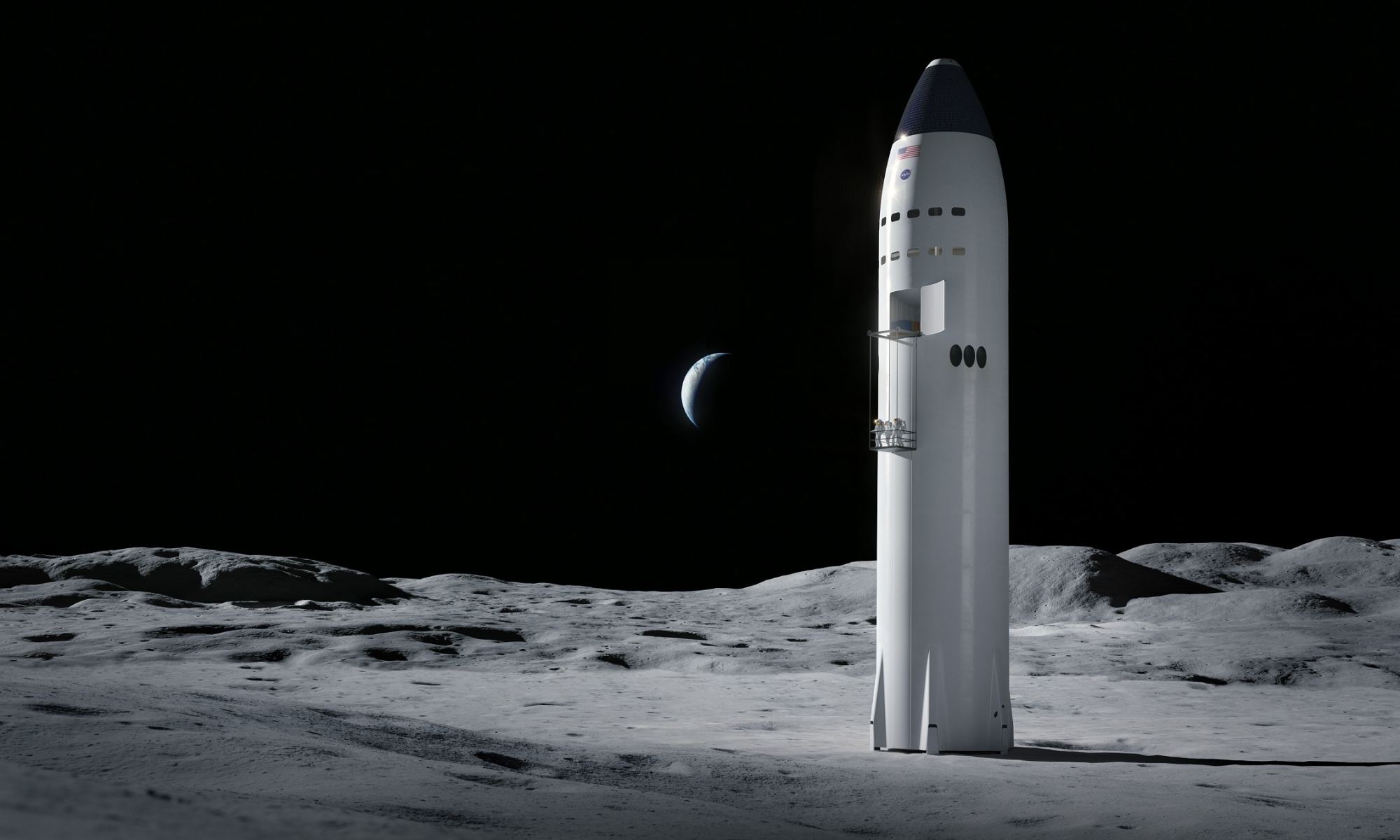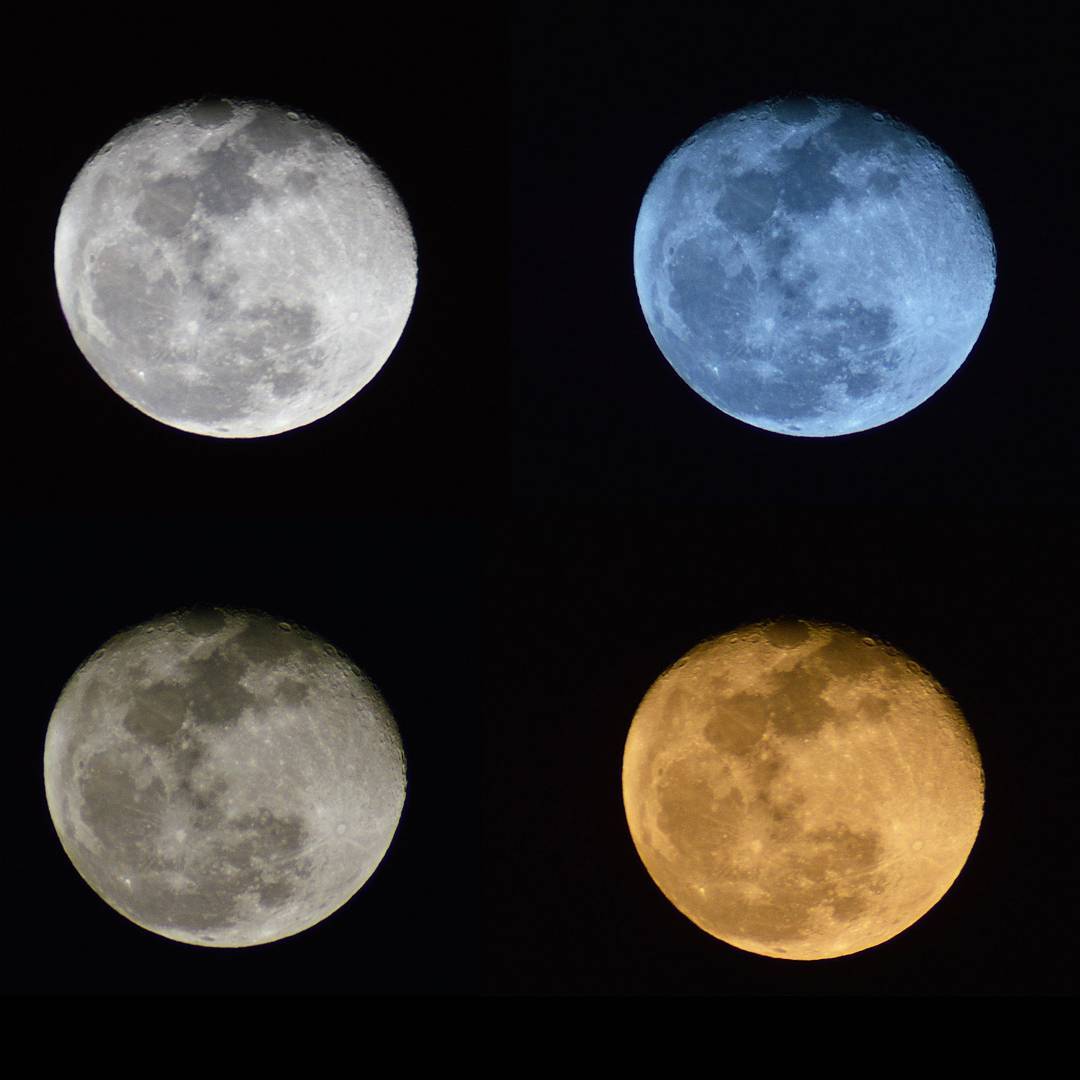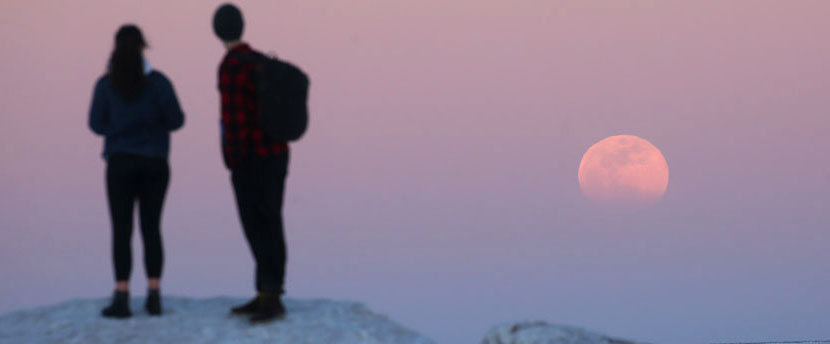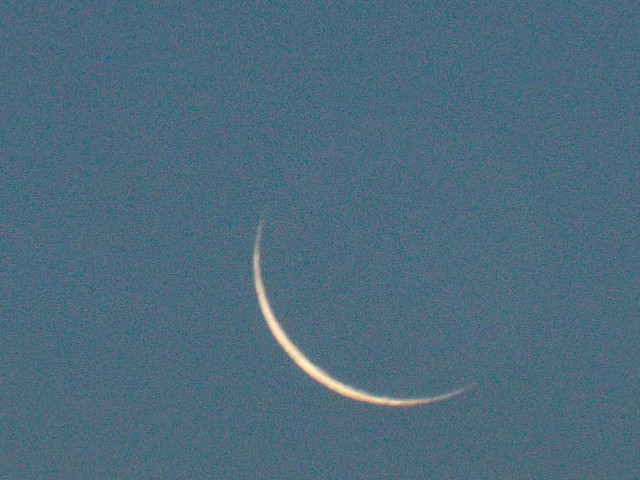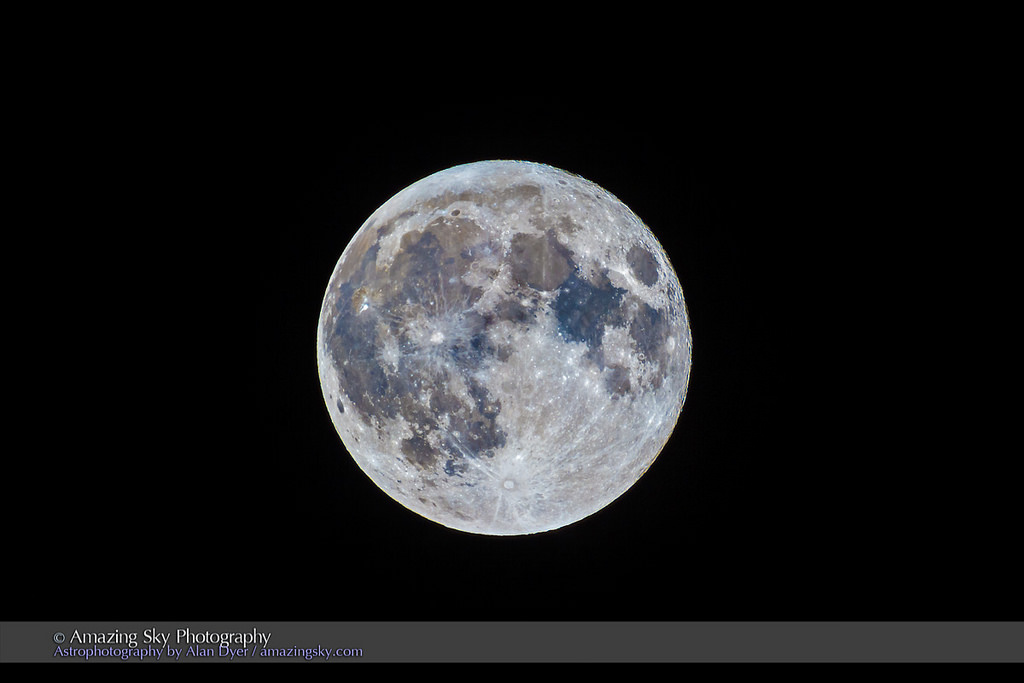NASA has announced a second lunar lander provider for its Artemis program, choosing Blue Origin’s National Team to deliver astronauts to the Moon’s south pole as early as 2029. Blue Origin’s lander will be part of the Artemis V mission. They join SpaceX, whose Starship is already slated to ferry astronauts to the lunar surface for Artemis III and IV.
Continue reading “Artemis V is Going to the Moon With Blue Origin”Musk Says That Refueling Starship for Lunar Landings Will Take 8 Launches (Maybe 4)
The fight over who gets to take the Artemis astronauts back to the Moon continues! It all began when NASA announced that they had awarded the contract for its Human Landing System (HLS), the reusable lunar lander that would ferry the Artemis III astronauts to the lunar surface. This decision did not sit well with the other two finalists, Blue Origin and Dynetics, who appealed the decision because NASA was showing “favoritism.”
The Government Accountability Office (GAO) rejected these appeals, which has prompted Blue Origin founder Jeff Bezos to bring out the big guns. In addition to filing a lawsuit in federal court and lobbying Congress, they have also waged a public relations war against SpaceX itself, calling their safety record and into question. In response, Elon Musk took to Twitter to address Blue Origin’s claims and set the record straight.
Continue reading “Musk Says That Refueling Starship for Lunar Landings Will Take 8 Launches (Maybe 4)”Blue Origin Offers a $2 Billion Discount to get Back in the Lunar Lander Game
Blue Origin has been busy lately. They launched their founder, Jeff Bezos, into space and put a bid in on NASA’s new Lunar Lander project. While SpaceX won that contract back in April, Blue Origin has continued to fight for their right to supply the space agency with an alternative lander. And recently, their not-quite-an-astronaut chief had added another fuel to the fire by offering to take $2 billion off the price tag of a Blue Origin lander.
Continue reading “Blue Origin Offers a $2 Billion Discount to get Back in the Lunar Lander Game”Boo! A Halloween Blue Moon
The final Blue Moon of the decade this weekend rounds out October 2020.
Halloween. It’s not only a great time to dress up in ghoulish garb going from house to house, but a great time for some (in 2020, socially-distanced) sidewalk astronomy. This year also offers up a special trick-or-treat event, as the second Full Moon of October falls on the very last day of the month.
Continue reading “Boo! A Halloween Blue Moon”Return to the Moon with Blue Origin’s Rockets and Lunar Lander Made Out of LEGO
Indulge your inner man-child (or woman-child) with these LEGO versions of the Blue Origin Blue Moon lunar lander, New Glenn rocket, and launch tower. This new design is currently gathering supporters on the LEGO Ideas website. If it gets enough supporters, LEGO will review it and possibly build it.
Continue reading “Return to the Moon with Blue Origin’s Rockets and Lunar Lander Made Out of LEGO”The Blue Origins Founder Wants to Get to the Moon by 2024
Blue Origin is going to the Moon. In an hour-long presentation in Washington DC on May 9th, Jeff Bezos spelled out his plans for reaching the Moon, confirming what many guessed he was hinting at in a tweet from the previous week.
Bezos and his company, Blue Origin, are developing a lunar lander capable of landing a large payload of 6.5 metric tons (14,330 lbs.) on the lunar surface. The lander is being called ‘Blue Moon’ and the target date for its rendezvous with the Moon is 2024.
Continue reading “The Blue Origins Founder Wants to Get to the Moon by 2024”Tiangong 1 Falls, Blue Moon Rises and Mars Takes Aim At Saturn

I apologize for the end-of-the-world title, but everything in it is true. And the world will still be here after it’s all done. On Friday (March 31) at 7:36 a.m. Central Time, the Moon will be full for the second time this month, which makes it a Blue Moon according to popular usage. Enjoy it. What with January’s Blue Moon and now this, we’ve chewed through all our Blue Moons till Halloween 2020.
I look forward to every full moon. Watching a moonrise, we get to see all manner of amazing atmospheric distortions play across the squat, orange disk. Once the sky’s dark, its outpouring of light makes walking at night a pleasure.
When a full moon occurs in spring, it hurries south down the ecliptic, the imaginary circle in the sky defining Earth’s orbit around the Sun. For northern hemisphere skywatchers, this southward sprint delays its rising by more an hour each night, forcing a quick departure from the evening sky. And that means blessed darkness for hunting down favorite galaxies and star clusters.
Tiangong 1 and a reentry simulation
As the Moon rolls along, the hapless Chinese space station Tiangong 1 hurtles toward Earth. Drag caused by friction with the upper atmosphere continues to shrink the spacecraft’s orbit, bringing it closer and closer to inevitable breakup and incineration. Since the Chinese National Space Administration (CNSA) lost touch with Tiangong 1 in March 2016, mission control can no longer power thrusters to de-orbit it at chosen time over a safe location like the ocean. The 9.3-ton (8,500 kg) station will burn up somewhere anywhere over a vast swath of the planet between latitudes 43°N and 43°S. Included within this zone are the southern half of Europe, the southern two-thirds of the U.S., India, Australia and much of Africa and South America.
Not until the day of or even hours before will have a clear idea of when and where the station will meet its fate. According to the latest update from the Aerospace Corp., which monitors falling spacecraft, reentry is expected on Easter Sunday (April 1) at 10:30 UT / 5:30 a.m. Central Time plus or minus 16 hours. This morning (March 29), the space station is circling Earth at about 118 miles (190 km) altitude. The lowest a satelllite can still make a complete orbit of the planet is about 62 miles (100 km). Below that, break-up begins.
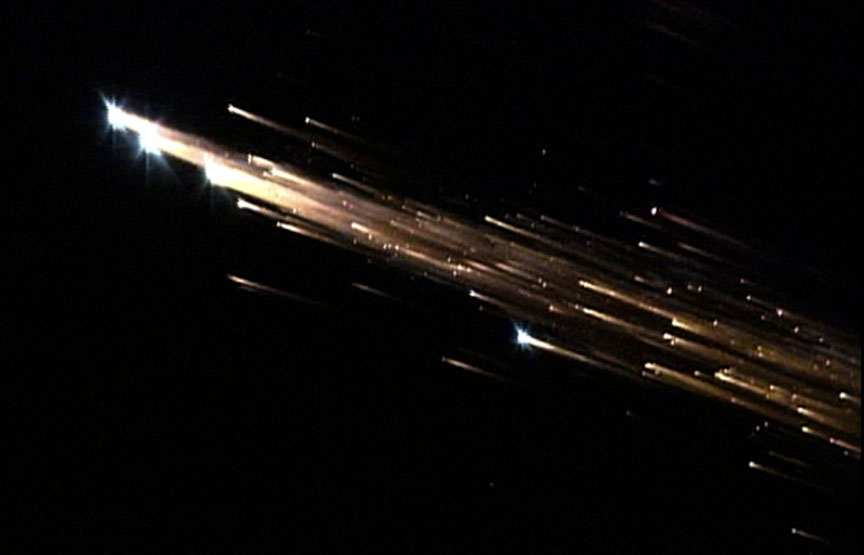
For up-to-the-minute updates on when to expect Tiangong 1’s orbit to decay and the machine to plunge to Earth, check out Joseph Remis’ Twitter page. Most of the space station is expected to burn up on reentry, but larger chunks might survive all the way to the ground. Since much more of the Earth’s surface is water these remnants will likely end up in the drink … but you never know. If Tiangong-1 does come down over a populated area, observers on the ground will witness a spectacular, manmade fireball day or night.

On the quieter side but nearly as eye-catching, Mars will overtake Saturn in the coming week, passing just 1° south of the ringed planet in a thrilling dawn conjunction on April 2. If the weather forecast doesn’t look promising that morning, the two planets will remain within 2° of each other now through April 6th, providing plenty of opportunities for a look.
You can easily tell them apart by color: Mars is distinctly red-orange and Saturn looks creamy white. Both are bright at around magnitude 0 though Mars is now a hair brighter by two-tenths of a magnitude. Will you be able to see the difference?
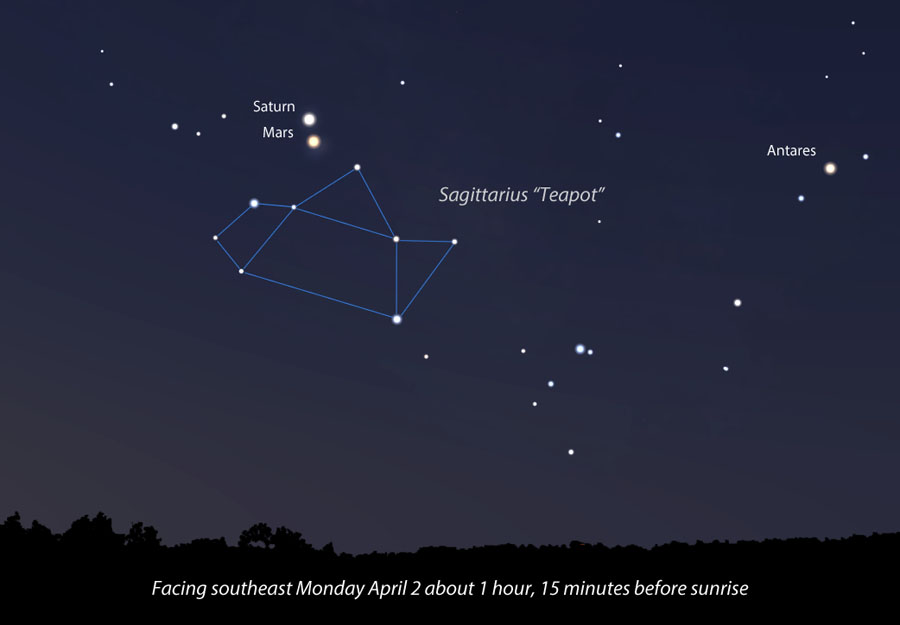
In most telescopes at low magnification both planets will comfortably fit in the same field of view. Saturn’s rings are tilted nearly wide open and quite beautiful. Mars appears gibbous and though still rather small, it’s brightening rapidly and drawing closer in time for its closest approach to Earth since 2003. Wishing you clear skies!
Boo! A Black Moon Halloween Weekend
This Halloween weekend’s top astronomical event features something that you won’t see in the sky.
By now, you’ve probably seen the stories circulating ’round ye ole web about how this month features a ‘Black Moon.’ The internet seems to love promulgating the passing of such curious calendrical oddities as Moons both Black, Blue and otherwise.
What’s all of the hoopla about? Well, simply put, the Moon reaches New phase this weekend on October 30th at 17:38 Universal Time (UT), marking the start of lunation 1161. This is the second New Moon for the month, as the first fell on October 1st, just 11 minutes into the month as reckoned in Universal Time.
Now, this isn’t at all rare or unusual; the synodic period of the Moon (that is, the time it takes to return to a similar phase, such as New back to New) is 29.5 days long, a period that shoehorns well in to a 31 day month like October, or occasionally, a 30 day month.
More Fun With Calendars
February is the only month that cannot contain a ‘repeat phase,’ leap year or no. Occasionally, a given phase such as New or Full can be absent from short February all together… sometimes, this oddity is also sometimes referred to as a ‘Black Moon.’ 2014 and 2033 are the nearest years to 2016 that are missing New Moons in February.
And then there’s the relict definition of a Blue Moon as the ‘3rd in an astronomical season with 4…‘ that can also be ascribed to a Black Moon as relates to New phase, as if we already lack enough multi-hued Moons in or lives.
Keep in mind, the moment of New is but an instant, a point a which the Moon’s longitude along the ecliptic plane equals the Sun’s. The Moon makes a miss of the Sun on most lunations, and only directly passes between the Sun and the Earth during an annular or solar eclipse. We’ve got one each coming up in 2017: an annular solar eclipse crossing the southern tip of South America on February 26th, and the historic return of totality to the United States on August 21st, 2017.
Said high profile solar eclipse next August also has a lesser role, as it fits that old-timey definition of the 3rd New Moon in an astronomical season with four. Of course, this is only the juxtaposition of the lunar cycle on our current Gregorian calendar, using time reckoned in UT/GMT.
Don’t fear the Black Moon. This year’s New Moon just misses Halloween. The next New Moon on Halloween (which, of course, is always a ‘Black Moon’) occurs in 2035.
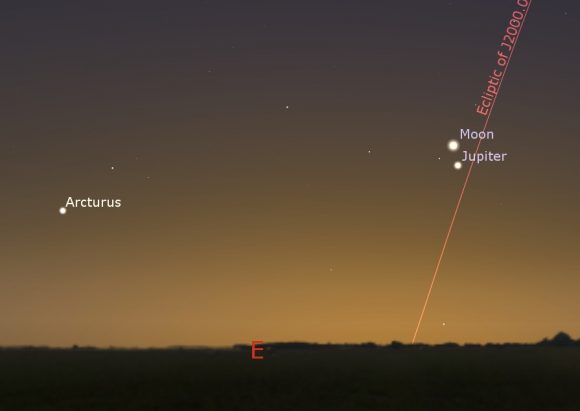
And we’ll let you in on a secret: astronomers don’t spend nights in mountaintop observatories discussing Black or Blue Moons… the term has more of an astrological tinge to it. Even in amateur astronomy circles, you sometimes hear the term ‘the dark of the Moon’ used to refer to the weeks surrounding New Moon, a prime time for deep sky astrophotography.
Looking for a New Moon-related observing challenge? Spotting the razor thin waxing or waning Moon is a fun feat of visual athletics. Look for a thin waning crescent Moon hanging near Jupiter on the morning of Friday, October 28th. This weekend, the first shot at catching the uber-thin Moon occurs for observers along a curve from southeastern Asia at dusk on October 31st westward at dusk. For Spain (and Astroguyz basecamp) the Moon will be 24 hours past New, and for the United States, the Moon will be 28 to 32 hours old at sunset for roaming Halloween ghouls and goblins, an easy catch.

A time change is also afoot this weekend, as folks in Europe and the UK ‘fall back’ one hour to standard time. This setback falls nearly as late as it can in 2016, and we now enter that wacky oneeek period where the world slowly slips back to standard time. Blame ‘Big Sugar’ for the latency in most of North America, as prospective trick-or-treaters now make their rounds during daylight hours. In most of the US and Canada, the switch occurs on Sunday, November 6th.
And there’s one more astronomical tie-in for Halloween: the holiday traces its roots back as one of the four cross-quarter days of yore, including Lammas Day, Groundhog Day, and May Day. Of course, the fixing of Hallow’s Eve on October 31st makes the midway date only approximate: in 2016, the actual mid-point occurs on November 10th.
Out of this world stuff to consider, as you inventory the night’s sugary bounty and contemplate the night sky.
A May Full ‘Blue Moon’ on Tap For This Weekend?
Brace yourselves. You are about to hear talk this week of an astronomical non-occurrence of the utmost in obscurity. We’re talking about this weekend’s Blue Moon.
Now, I know what you’re thinking. Isn’t a ‘Blue Moon’ the second Full Moon of the month? How can a Blue Moon fall on the 21st? Trust me, we’re both correct… in a sense. The term ‘Blue Moon’ has taken on several meanings over the last few decades, with the ‘the second Full Moon in a calendar month containing two Full Moons’ now in vogue across ye old Internet. It seems the masses just can’t get enough of Super, Blood, Honey and Moons Black and Blue. We point to last month’s rumored ‘Green Moon‘ as evidence. (Spoiler alert: it wasn’t).
No, we’re talking instead of a Blue Moon in an old-timey sense. You’ll be hard pressed to explain source of this week’s Blue Moon for sure, though it has a fascinating origin story.
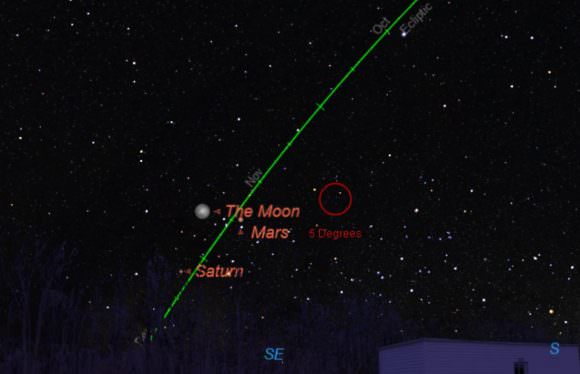
The term seems to come down to us from the Maine Farmer’s Almanac, which denoted the ‘third Full Moon in an astronomical season with four as blue.’ The lunar synodic period of 29.5 days — the length of time it takes the Moon to return to a like phase, such as New to New, or Full to Full — means that on most years, there are 12 Full Moons. 29.5 times 12 comes out about 11 days short of a 365.25 day solar year at 354 days, meaning that about every three years, we have a year with 13 Full Moons.
Not a big deal, you say? Well, it assures that lunar based forms of reckoning time, such as the Muslim calendar loses 11 days relative to the Gregorian calendar every year.
Here’s how the 2016 Blue Moon breaks down:
March Equinox- March 20th 4:30 Universal Time (UT)
March Full Moon- March 23rd 12:02 UT
April Full Moon- April 22nd 5:22 UT
May Full Moon- May 21st 21:17 UT (3rd in an astronomical season, ‘blue’)
June Full Moon- June 20th 11:05 UT
June Solstice- June 20th 22:34 UT
The last time we had a season with four Full Moons was August 21st, 2013, and the next Blue Moon under this rule is May 18th, 2019.
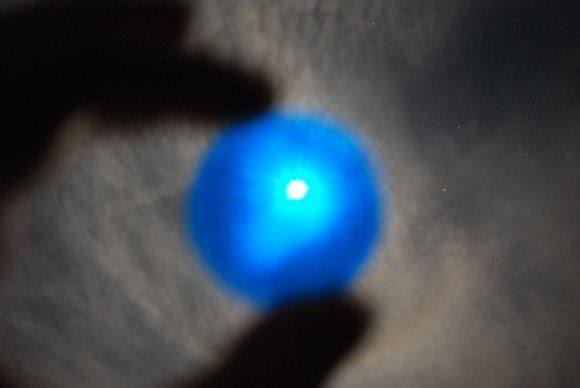
Of course, a deeper riddle is just why the Maine Farmer’s Almanac termed this occurrence as Blue, and why they picked the 3rd of a season with 4 specifically… one legend goes that the extra anomalous Full Moon was depicted on the calendar in blue ink to stand out. We’d love to get our hands on a copy of the Old Maine Farmer’s Almanac circa late 19th early 20th century era to see if this was indeed the case. This is on our list of research projects, next time we find ourselves back in our home state of Maine.
Types of Blue Moons
We’ve chronicled the tales of Moons, both Black and Blue. Sky and Telescope also explored the role they had in introducing the modern day Blue Moon into common vernacular. We’ll admit, the ‘2nd in a month with two Full Moons’ is a much easier rule to explain!
Of course, the Moon isn’t scheduled to actually appear blue this week… that’s actually a much rarer occurrence, and the Moon doesn’t need to even be Full for this to happen. In September 23rd, 1950, the residents of the northeastern United States saw the 94% illuminated waxing gibbous Moon rise with a distinctly bluish cast, owing to the high concentration of oily soot particles suspended high in the atmosphere, scattering out red and yellow light but filtering through blue. Reports of similar Blue Moons dot observational lore, though to our knowledge, no one has actually captured an image of such a cerulean apparition of the Moon.
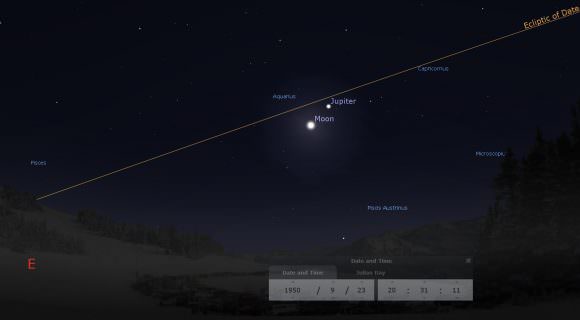
Is the Moon ever really Full? You can make a pretty good argument that the Moon as seen from the Earth is never truly fully illuminated, though it gets really close. Full 100% illumination would occur when the Moon is exactly opposite to the Sun, but when this occurs, the Moon also passes into the dark shadow of the Earth, during a total lunar eclipse.
Fun fact: the next ‘Blue Blood Moon’ lunar eclipse occurs on January 31st, 2018, following the ‘2nd Full Moon in a month with 2′ rule.
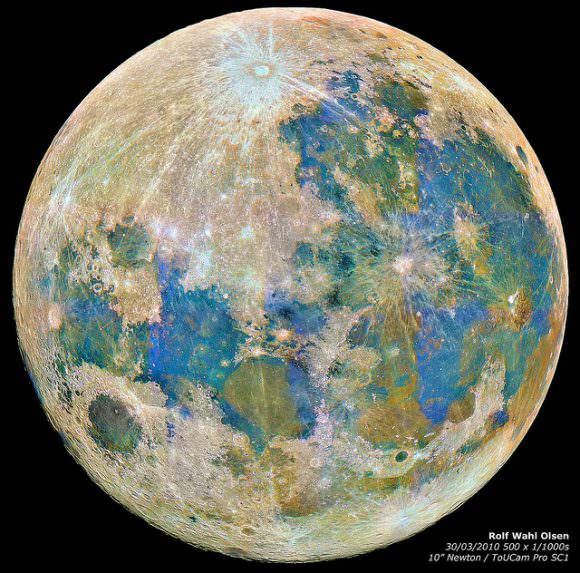
The May Full Moon also has the romantic name of the Full Flower, Corn Planting or Milk Moon in Algonquin Indian lore.
In 2016, the Moon continues to follow a shallow path relative to the ecliptic plane, which in turn traces out the Earth’s path around the Sun. 2015 was the bottoming out of the ‘shallow year’ known as a minor lunar standstill, and we’re now headed towards a hilly or steep year of a major lunar standstill in 2025, a time once every 19 years when the Moon rides high in the sky, adding its 5 degree inclination relative to the ecliptic plane.
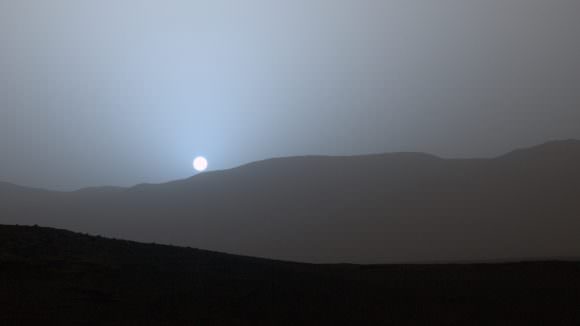
Will this weekend’s olden times Blue Moon gain traction in today’s fast-paced social media news cycle? Stay tuned!
April Lunacy: Getting Ready for the Full ‘Mini-Moon’
Do you welcome the extra evening light of the Full Moon, or curse the additional light pollution? Either way, this week’s Full Moon on Friday April 22nd is special. It’s the smallest Full Moon of 2016, something we here at Universe Today have christened the Mini-Moon.
Mini-Moon 2016: This year’s Mini-Moon falls on April 22nd at 5:25 Universal Time (UT), just 13 hours and 19 minutes after lunar apogee the evening prior at 16:06 UT on April 21st. Though apogee on the 21st is 406,350 km distant – a bit on the far end, but the third most distant for the year by 300 km — this week’s Full Moon is the closest to apogee for 2016 time-wise. The 2015 Mini-Moon was even closer, in the 10 hour range, but you’ll have to wait until December 10th, 2030 to find a closer occurance.
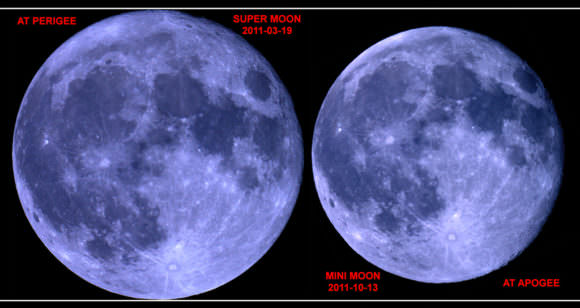
What is the Mini-Moon, you might ask? As with the often poorly defined Supermoon, we like to eschew the ambiguous ‘90% of its orbit’ definition, and simply refer to it as a Full Moon occurring within 24 hours of lunar apogee, or its farthest point from the Earth in its orbit.
Fun fact: the 29.55 day period from perigee to perigee (or lunar apogee-to-apogee) is known as an anomalistic month.

Thank our Moon’s wacky orbit for all this lunacy. Inclined 5.14 degrees relative to the ecliptic plane, the Moon returns to the same phase (say, Full back to Full) every 29.53 days, known as a synodic month. The Moon can appear 33.5′ across during perigee, and shrink to 29.4′ across near apogee.
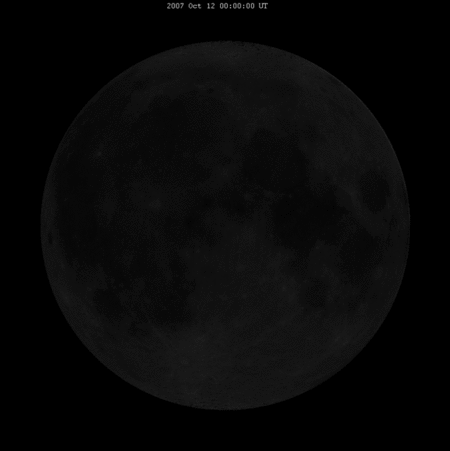
And don’t fear the ‘Green Moon,’ and rumors going ’round ye’ ole internet that promise a jaded Moon will occur in April or May; this is 100% non-reality based, seeking to join the legends of Super, Blood, and Full Moons, Black and Blue.
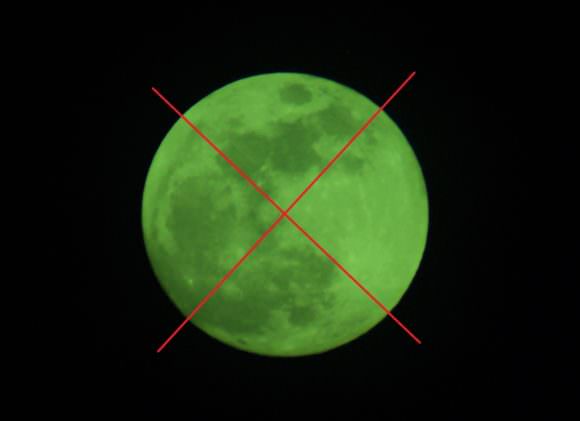
The April Full Moon is also known as the Full Pink Moon to the Algonquin Indians. The April Full Moon, can, on occasion be the Full Moon ushering in Easter (known as the Paschal Moon) as per the rule established by the 325 AD council of Nicaea, stating Easter falls on the first Sunday after the first Full Moon after the fixed date of the Vernal Equinox of March 21st. Easter can therefore fall as late as April 25th, as next occurs on 2038. The future calculation of Easter by the Church gets the Latin supervillain-sounding name of Computus.
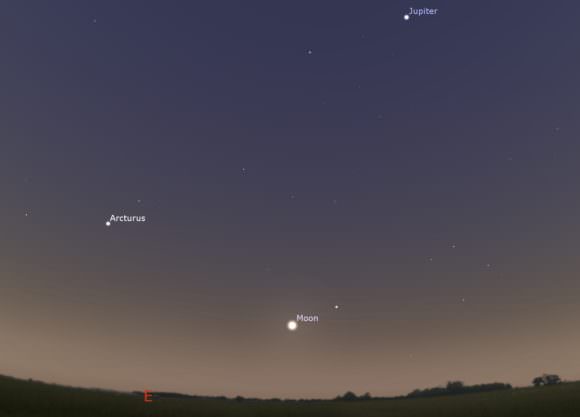
Of course, the astronomical vernal equinox doesn’t always fall on March 21st, and to complicate matters even further, the Eastern Orthodox Church uses the older Julian Calendar and therefore, Easter doesn’t always align with the modern western Gregorian calendar used by the Roman Catholic Church.
The Moon can create further complications in modern timekeeping as well.
Here’s one wonderful example we recently learned of in our current travels. The Islamic calendar is exclusively based on the synodic cycle of the Moon, and loses 11 days a year in relation to the Gregorian solar calendar. Now, Morocco officially adopted Daylight Saving (or Summer) Time in 2007, opting to make the spring forward during the last weekend of March, as does the European Union to the north. However, the country reverts back to standard time during the month of Ramadan… otherwise, the break in the daily fast during summer months would fall towards local midnight.
You can see a curious future situation developing. In 2016, Ramadan runs from sundown June 5th, to July 4th. Each cycle begins with the sighting of the thin waxing crescent Moon. However, as Ramadan falls earlier, you’ll get a bizarre scenario such as 2022, when Morocco springs forward on March 27th, only to fall back to standard time six days later on April 2nd on the start of Ramadan, only to jump forward again one lunation later on April 30th!
Morocco is the only country we’ve come across in our travels that follows such a convoluted convention of timekeeping.
Fun fact #2: the next ‘Mini-Moon’ featuring a lunar eclipse occurs on July 27th 2018.
And the Spring Mini-Moon sets us up for Supermoon season six months later this coming October-November-December. Though lunar perigees less than 24 hours from Full usually occur as a trio, an apogee less than 24 hours from Full is nearly always a solitary affair, owing to the slightly slower motion of the Moon at a farther distance.
Don’t miss the shrunken Mini-Moon rising on the evenings of Thursday April 21st and Friday 22nd, coming to a sky near you.

